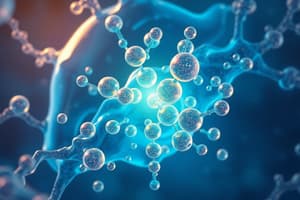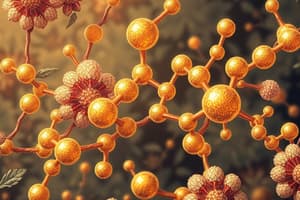Podcast
Questions and Answers
Which term best describes the characteristic of lipids as biological molecules?
Which term best describes the characteristic of lipids as biological molecules?
- Hydrophilic
- Highly polar
- Water-soluble
- Nonpolar (correct)
What is a common characteristic of lipids that affects their solubility?
What is a common characteristic of lipids that affects their solubility?
- They contain a polar head group and a long nonpolar tail (correct)
- They are highly charged
- They are soluble in inorganic solvents
- They are readily soluble in water
What is the key structural component that defines a fatty acid?
What is the key structural component that defines a fatty acid?
- A phosphate group
- A carboxyl head group attached to a nonpolar hydrocarbon chain (correct)
- A glycerol backbone
- A nonpolar steroid ring
If a fatty acid is described as 'monounsaturated', what does this imply about its structure?
If a fatty acid is described as 'monounsaturated', what does this imply about its structure?
How are the double bond positions indicated when naming fatty acids?
How are the double bond positions indicated when naming fatty acids?
Which of the following characteristics is most accurate regarding fatty acid solubility in water?
Which of the following characteristics is most accurate regarding fatty acid solubility in water?
What is the primary function of lipids in biological systems?
What is the primary function of lipids in biological systems?
Which positions are phosphorylated in phosphatidylinositol to form PIP3?
Which positions are phosphorylated in phosphatidylinositol to form PIP3?
What is the backbone structure of sphingolipids?
What is the backbone structure of sphingolipids?
What does 'COOH' represent in the context of fatty acid structure?
What does 'COOH' represent in the context of fatty acid structure?
What type of bond attaches a fatty acid to the backbone of a sphingolipid?
What type of bond attaches a fatty acid to the backbone of a sphingolipid?
What is generally attached to the lipid of glycolipids?
What is generally attached to the lipid of glycolipids?
What is characteristic about the ring system of a steroid?
What is characteristic about the ring system of a steroid?
What is the typical position of the first double bond in most unsaturated fatty acids?
What is the typical position of the first double bond in most unsaturated fatty acids?
In polyunsaturated fatty acids, where are the additional double bonds located besides the first one?
In polyunsaturated fatty acids, where are the additional double bonds located besides the first one?
What does the 'omega' designation in fatty acids refer to?
What does the 'omega' designation in fatty acids refer to?
How does the length of the fatty acid chain influence its properties?
How does the length of the fatty acid chain influence its properties?
Why do saturated fatty acid chains pack more tightly than unsaturated fatty acid chains?
Why do saturated fatty acid chains pack more tightly than unsaturated fatty acid chains?
What is the stereochemistry of the double bonds in naturally occurring unsaturated fatty acids?
What is the stereochemistry of the double bonds in naturally occurring unsaturated fatty acids?
What process results in the formation of trans fats as a byproduct?
What process results in the formation of trans fats as a byproduct?
How do trans fats affect LDL cholesterol levels?
How do trans fats affect LDL cholesterol levels?
What type of bond is broken during the hydrolysis of a triglyceride?
What type of bond is broken during the hydrolysis of a triglyceride?
Which of the following is a product of the chemical hydrolysis of triglycerides?
Which of the following is a product of the chemical hydrolysis of triglycerides?
How do triglycerides differ from membrane lipids?
How do triglycerides differ from membrane lipids?
Compared to free fatty acids, triglycerides are generally described as:
Compared to free fatty acids, triglycerides are generally described as:
Where are triglycerides typically stored in the body?
Where are triglycerides typically stored in the body?
What characteristic does NOT describe the general properties of triglycerides?
What characteristic does NOT describe the general properties of triglycerides?
Enzymatic hydrolysis of triglycerides involves the addition of _______ across the _______ bond.
Enzymatic hydrolysis of triglycerides involves the addition of _______ across the _______ bond.
In a phospholipid, what is the main difference compared to a triglyceride?
In a phospholipid, what is the main difference compared to a triglyceride?
In a phosphoglyceride, what type of bond connects the fatty acid to the glycerol backbone?
In a phosphoglyceride, what type of bond connects the fatty acid to the glycerol backbone?
What is the linkage type that connects the phosphate group of a phosphoglyceride to another group (X)?
What is the linkage type that connects the phosphate group of a phosphoglyceride to another group (X)?
What is the molecule connected to the phosphate group in phosphatidylcholine?
What is the molecule connected to the phosphate group in phosphatidylcholine?
What is the net charge of phosphatidylcholine at physiological pH?
What is the net charge of phosphatidylcholine at physiological pH?
Where is phosphatidylserine commonly found in the plasma membrane?
Where is phosphatidylserine commonly found in the plasma membrane?
What is the net charge of phosphatidylethanolamine at physiological pH?
What is the net charge of phosphatidylethanolamine at physiological pH?
Which characteristic is associated with a phosphatidylethanolamine's structure, leading to membrane curvature?
Which characteristic is associated with a phosphatidylethanolamine's structure, leading to membrane curvature?
What feature of phosphatidylinositol allows it to have multiple distinct signaling roles?
What feature of phosphatidylinositol allows it to have multiple distinct signaling roles?
Flashcards
What are lipids?
What are lipids?
Lipids are a diverse group of biological molecules that share a common feature: they are largely hydrophobic (water-repelling).
What are the key functions of lipids?
What are the key functions of lipids?
Lipids are essential for various functions in living organisms, including energy storage, cell membrane formation, insulation, and hormone production.
Describe a fatty acid.
Describe a fatty acid.
A fatty acid is a long chain of carbon atoms with a carboxyl group (COOH) at one end. This structure makes them amphipathic, meaning they have both hydrophilic (water-loving) and hydrophobic (water-fearing) regions.
What are saturated fatty acids?
What are saturated fatty acids?
Signup and view all the flashcards
What are unsaturated fatty acids?
What are unsaturated fatty acids?
Signup and view all the flashcards
How are double bond positions in fatty acids indicated?
How are double bond positions in fatty acids indicated?
Signup and view all the flashcards
What are glycerophospholipids?
What are glycerophospholipids?
Signup and view all the flashcards
What are steroids?
What are steroids?
Signup and view all the flashcards
Sphingolipids
Sphingolipids
Signup and view all the flashcards
Sphingomyelin
Sphingomyelin
Signup and view all the flashcards
Glycolipids
Glycolipids
Signup and view all the flashcards
Archaeal Lipids
Archaeal Lipids
Signup and view all the flashcards
Steroids
Steroids
Signup and view all the flashcards
Number of carbons in fatty acids
Number of carbons in fatty acids
Signup and view all the flashcards
Location of the first double bond
Location of the first double bond
Signup and view all the flashcards
Double bonds in polyunsaturated fatty acids
Double bonds in polyunsaturated fatty acids
Signup and view all the flashcards
Omega designation
Omega designation
Signup and view all the flashcards
Melting point and fluidity of fatty acids
Melting point and fluidity of fatty acids
Signup and view all the flashcards
Packing of saturated fatty acids
Packing of saturated fatty acids
Signup and view all the flashcards
Kink in unsaturated fatty acids
Kink in unsaturated fatty acids
Signup and view all the flashcards
Hydrogenation
Hydrogenation
Signup and view all the flashcards
Phosphatidylcholine
Phosphatidylcholine
Signup and view all the flashcards
Phosphatidylserine
Phosphatidylserine
Signup and view all the flashcards
Phosphatidylethanolamine
Phosphatidylethanolamine
Signup and view all the flashcards
Phosphatidylinositol
Phosphatidylinositol
Signup and view all the flashcards
Phosphoglyceride
Phosphoglyceride
Signup and view all the flashcards
Phosphoester bond
Phosphoester bond
Signup and view all the flashcards
Ester bond
Ester bond
Signup and view all the flashcards
Triglyceride Formation
Triglyceride Formation
Signup and view all the flashcards
Phospholipids
Phospholipids
Signup and view all the flashcards
Monoglycerides and Diglycerides
Monoglycerides and Diglycerides
Signup and view all the flashcards
Hydrophobicity of Triglycerides
Hydrophobicity of Triglycerides
Signup and view all the flashcards
Energy Density of Triglycerides
Energy Density of Triglycerides
Signup and view all the flashcards
Storage of Triglycerides
Storage of Triglycerides
Signup and view all the flashcards
Hydrolysis of Triglycerides
Hydrolysis of Triglycerides
Signup and view all the flashcards
Lipase Activity
Lipase Activity
Signup and view all the flashcards
Study Notes
Lipids Structure and Properties
- Lipids are highly insoluble in polar biological molecules like chloroform and acetone
- Lipids are generally soluble in nonpolar solvents
- Lipids have various functions including signaling molecules.
Functions of Lipids
- Lipids function in energy storage.
- Some lipids are very hydrophobic
- Others have polar groups
Types of Lipids
- Lipids are divided into two major groups:
- Those with a polar head group and long nonpolar tails (like fatty acids)
- Those with no polar group, like cholesterol and steroids
Fatty Acids
- Function:
- Energy source.
- General properties:
- Contain a carboxyl head group (polar) attached to a hydrocarbon tail (nonpolar).
- This makes them amphipathic (part polar, part nonpolar)
- Important for cells because it makes them water soluble
- Solubility in water varies
- Characteristics:
- Saturated (no double bonds)
- Monounsaturated (one double bond)
- Polyunsaturated (multiple double bonds).
- Numbering of carbon atoms begins at the carboxyl carbon.
- Nomenclature:
- Number of carbons separated by colon from the number of double bonds.
- Position of the double bond is indicated by delta(Δ) notation or omega (ω) notation.
- Number of carbons separated by colon from the number of double bonds.
- Examples:
- Palmitic acid
- Oleic acid
- Linoleic acid
- Linolenic acid
- Arachidonic acid
Fatty Acids: Number of Carbons and Double Bonds
- Fatty acids with more carbon atoms have higher melting points.
- Saturated fatty acids have higher melting points than unsaturated fatty acids.
- Unsaturated fatty acids have kinks in the tail.
- The structure of the fatty acid chain influences how it interacts with water and how other molecules interact with it.
Triglycerides (Triacylglycerols)
- Made of glycerol and fatty acids.
- High energy storage molecule because of its hydrophobic alkyl tails
- Stored in adipose cells.
- Hydrolysis occurs to release free fatty acids
Hydrolysis Of Triglycerides
- Enzymatic: Adds water across the ester bond.
- Chemical: Uses NaOH and KOH to hydrolyze the bond, making fatty acid salts.
Membrane Lipids
- They are components of cell membranes.
- Include phospholipids and glycolipids.
- Phospholipids are constructed from glycerol and fatty acids
- Glycolipids are constructed from sphingosine or glycerol and fatty acids.
Phosphoglycerides (Phosphoacylglycerols)
- Phosphoglycerides are a type of glycerophospholipid
- A phosphoglyceride is made of a glycerol backbone, two fatty acid chains, a phosphate group and head group (X)
- Different groups (X) include choline, ethanolamine, serine, or inositol
Sphingolipids
- Found primarily in the central nervous system.
- Constructed from sphingosine.
- Attached to fatty acid chain via an amide bond
- X=head group.
Glycolipids
- Contain a carbohydrate attached to a lipid backbone.
- Typically found in nerve and brain membranes.
Archaeal Lipids
- Allow archaeal bacteria to survive in extreme conditions.
- Composed of isoprenoid chains with ether linkages.
Steroids
- Have a fused ring structure.
- Example: cholesterol (important component of cell membranes).
- Important in cell signaling.
Studying That Suits You
Use AI to generate personalized quizzes and flashcards to suit your learning preferences.




